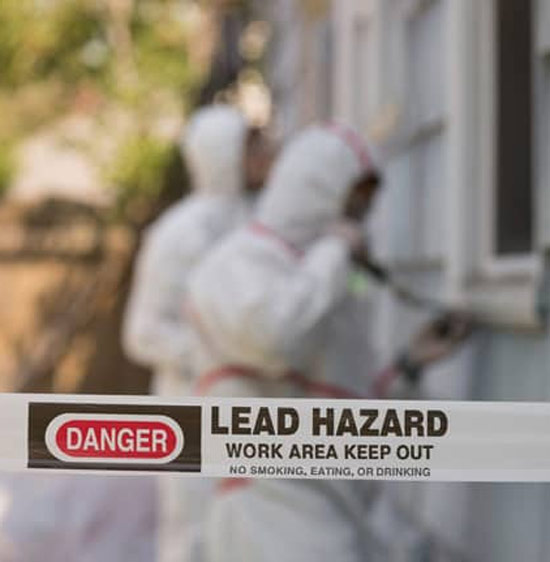Lead Removal Contractors-- Seasoned Experts for Lead Reduction
Lead Removal Contractors-- Seasoned Experts for Lead Reduction
Blog Article
Comprehensive Guide on Effective Lead Infraction Elimination Methods
In the realm of ecological safety, dealing with lead infractions demands a meticulous and organized strategy. This extensive guide starts by highlighting the critical preliminary steps of identifying lead dangers through advanced assessment and testing techniques. Strategies such as XRF evaluation and dirt clean sampling are vital in identifying contamination resources. In addition, the overview elaborates on the relevance of sticking to rigid security procedures during the elimination procedure, consisting of the usage of appropriate PPE and isolating affected areas (Lead Paint Removal Company). The subsequent sections assure to talk about post-removal verification and preventive approaches, making sure long-lasting safety and conformity. Discover the complex details that make these methods not just reliable however vital.
Identifying Lead Dangers
Identifying lead dangers is a vital initial step in minimizing the risks related to lead exposure. Lead, a poisonous metal, can be present in different ecological mediums, including paint, dirt, water, and dirt. It presents severe health and wellness threats, specifically to children and expecting females, leading to neurological damage and developmental delays. As a result, specific recognition of potential lead sources is necessary for reliable remediation.
The first stage in identifying lead hazards involves understanding common lead sources within the developed atmosphere. Structures developed before 1978 are especially vulnerable due to the prevalent use of lead-based paint during that duration. In addition, dirt contamination can occur from weakening exterior paint, commercial discharges, or historical usage of leaded gas.
One more considerable source is lead piping and plumbing components, which can seep lead right into alcohol consumption water. Durable goods such as playthings, porcelains, and imported items may also have harmful lead levels. Especially, work-related atmospheres and hobbies involving lead can track impurities right into homes.
Assessment and Testing
When addressing lead dangers, effective evaluation and screening are critical. First evaluation typically includes an aesthetic evaluation to recognize potential lead sources, such as wearing away paint or contaminated dust.

Dirt wipe sampling is one more critical technique, especially in household setups. By collecting samples from floors, windowsills, and other surfaces, this technique gives understandings right into potential exposure risks. Dirt testing around building perimeters is important to discover lead contamination that might present dangers, particularly to kids.
Safe Elimination Procedures
Upon completing extensive evaluation and testing, executing safe explanation removal treatments is the following important phase in dealing with lead dangers. This process ensures that lead-contaminated products are properly and securely removed, reducing risk to both employees and citizens. The very first step entails separating the affected location making use of plastic sheeting and appropriate securing methods to avoid the spread of lead dirt.
Workers should don ideal individual protective equipment (PPE), consisting of respirators, gloves, and non reusable coveralls, to alleviate exposure. Using specialized devices and wet approaches, such as damp sanding or making use of HEPA-filtered vacuums, lowers the dispersion of lead particles. It is critical to prevent completely dry fining sand or rough blasting, as these see page techniques can generate unsafe lead dust.
Garbage disposal is one more essential element; all contaminated products must be firmly bagged and classified according to EPA and local guidelines. Additionally, detailed cleaning of the workplace with HEPA vacuums and damp wiping makes sure the removal of residual lead fragments.
Post-Removal Verification

Verification of effective lead removal, referred to as post-removal confirmation, is crucial to ensure the security and habitability of the remediated location. This procedure entails a series of precise analyses and examinations designed to discover any kind of recurring lead particles that may present wellness threats. The initial step normally consists of an aesthetic evaluation to assess the completion and quality of the remediation work. This assessment makes sure that all recognized resources of lead have been addressed and that no visible signs of contamination remain.
Following the aesthetic inspection, environmental sampling is carried out. This involves collecting dirt, dirt, and sometimes water samples from the remediated location. Recognized research laboratories analyze these examples to gauge lead degrees, ensuring they fall listed below the security thresholds established by governing bodies such as the Epa (EPA)
In addition, air quality screening may be performed to detect air-borne lead bits, especially in instances where considerable lead-based paint elimination or remodelling has actually happened. The results of these examinations offer measurable information confirming that the lead degrees are within acceptable limits.
Inevitably, post-removal verification functions as an important checkpoint, verifying the performance of the lead abatement initiatives and securing the health of passengers and visitors.
Safety Nets and Upkeep

A vital safety net includes making use of lead-safe licensed professionals for any kind of remodelling, fixing, or painting activities. These specialists are learnt methods that decrease lead dust and debris. In addition, maintaining painted surface areas to stay clear of chipping or peeling his explanation is crucial, as weakening paint can release lead fragments right into the environment.
Educational efforts targeting residential or commercial property proprietors and lessees regarding the risks of lead and the value of reporting any kind of possible hazards can even more improve preventative initiatives. Regular cleansing making use of HEPA vacuums and wet mopping techniques can substantially minimize lead dirt buildup.
Verdict
In summary, effective lead infraction removal demands a precise approach incorporating extensive assessment, specific testing, and rigorous removal treatments. Continuous examinations and maintenance are essential to alleviate future lead hazards, therefore protecting public wellness and guaranteeing continual compliance with regulative needs.
Report this page